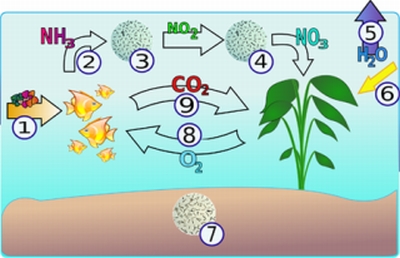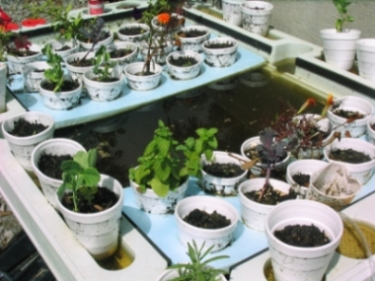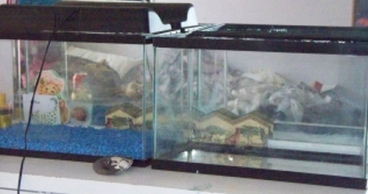| | | |
Aquaponics
An awesome homeschool science project!
| | |
A Homeschool Life Science Project  
Aquaponics has always been fascinating to me. Therefore, when I saw an empty, ready to be discarded, play pool table I snatched it up before it went to the trash.  
This is one of our summer science projects along with potato bins and creating a weed free garden with landscape fabric.
What is Aquaponics? Aquaponics is the system or the development of a system that is beneficial to both plants and aquatic animals and bacteria in a recirculating environment where all can thrive and grow.
What does that mean? It means, fish and plants and bacteria work together so that each of them can survive and grow.
Aquaponics is a mix of hydroponics (growing plants without soil) and aquaculture (growing fish for food). It can be done on a small scale as I will show on this page or on a large scale as a possible lucrative career.
The setup involves fish (they eat and excrete nitrogenous wastes), bacteria (convert the wastes to nitrates) and plants (use the nitrates) and gravel (acts to filter the cycling water and home to bacteria).
The most important concept behind aquaponics is the nitrogen cycle.
Nitrogen Cycle

This image is a work of an Environmental Protection Agency employee, taken or made
during the course of an employee's official duties.
As works of the U.S. federal government, all EPA images are in the public domain.
Explanation of the Nitrogen Cycle.
In order to survive, all forms of life need nitrogen. The air has a significant amount of nitrogen in the form of N2. The problem is most most life forms can't use Nitrogen in that form. Plants get their Nitrogen in a fixed form such as nitrate ions, ammonia, or urea. Animals get their Nitrogen from plants or from animals that have eaten plants.
The nitrogen in the air is fixed in a couple of ways but for this discussion we will just discuss by bacteria. Some of these bacteria are in the soil, or water or work with legume plants.
Some forms of Nitrogen such as ammonia can be taken up by plants through their roots but most plants get Nitrogen that has been further processed by bacteria.
This cycle is completed when the plants or animals die and start decaying releasing Nitrogen which is then acted upon by bacteria.
An important note is that bacteria act in two stages, first on the Nitrogen then on the ammonia. While ammonia can be taken up by plants it is toxic to fish.
Aquaponics uses this information. A very simplified explanation starts in the setup. First, fish in an operating aquarium are fed. They excrete nitrogenous wastes which are converted by bacteria in the system to ammonia. If the ammonia builds up in the tank the fish will die. Other bacteria continue to break the Nitrogen down in the water and in the grow bed. By cycling the ammonia/nitrogenous waste filled water to the plants, the plants take up forms of the nitrogen out of the water. The water then filters down through the planting medium and returns to the tank, fresh and clean.
The diagram below illustrates what happens in an aquarium setting or fish pond. In this picture, the plants are water plants. In our system the water is pumped out to the plants, which are regular herbs and garden plants, and then recycled back to the fish.

Thanks to author of picture Lukas3 from Wikimedia Commons.
Explanation of the above diagram.
(1) Food and nutrients are added and fish eat it.
(2) Fish excrete Urea and Ammonia.
(3) Ammonia is converted to Nitrites by good bacteria.
(4) Nitrites are converted to Nitrates by good bacteria and Nitrates are removed by plants and periodic water changes.
(5) Water evaporates.
(6) Light from sun or other source.
(7) Oxygen Cycle.
(8) O2 is produced by the plants.
(9) CO2 produced by Fish
Applications and Careers 
Aquaponics can be used as an alternative farming method. If successful systems are created, hungry people world wide can be fed nutritious and pesticide free food. However, another benefit is that it uses recycled water which means after setup very little water is needed to keep the system functioning. Even drought stricken areas can continue to grow food.
Our Experiments and Results. 
First Try As I said,this began in early spring when we were sorting and getting rid of junk and one of the items was a large, plastic, kids pool table. I really wanted this to work but the fish died and some just disappeared. Coons maybe. The basic idea was to fill the pool with water. Add fish. Cut thin styrofoam plates to hold the plants. Add the plants and float them on the water. We also added an air pump but by that time we had already lost one fish. The plants survived but there were problems. The water turned nasty. Mosquitoes started breeding in the water. I thought the fish would eat them. Of course, they need to be alive to do that. The dogs were snatching the cups and coons or the cat were eating the fish.  I still think I can get this to work.
The biggest problem being the changes in weather. We had lots of rain which overflowed the system a couple of times. The dogs then would grab the cups and chew on them and eat the plants. And the fish needed to eat the mosquitoes and to stay alive. The racoons and the cat need to be kept away from the system.
The alternative patterns of cool weather, rain and heat probably were the most detrimental to the system. This will need to be considered in any future outdoor aquaponic systems.
Also, adding a water pump to recirculate the water perhaps through a pvc tube with the plants nested in gravel in it might also help to keep the water clean. I still have the table. Next year, I might just try again. Second Try I began this system mid-summer when it started to look like our first system was failing. Being mid-summer, it was hot and I wanted to create a system that might work indoors all year long. The fish survived this time but the plants started strong and then withered. The basic idea was to use two aquariums. One aquarium would be for the fish and the other would be where the water would filter throuh a grow bed into the aquarium and then manually recycled to the plants or the fish. The grow bed was a plastic tub that sat on top of the fish tank. Holes were drilled in the bottom to drain into the tank. An indoor grow light would give supplemental light. This system appeared to work but it too had problems. Primarily, me. I didn't consistently water the plants. Also, we kept taking out water from the fish tank and giving it to the plants and refilling the fish tank with water treated with clorine remover instead of recycling the water back to the fish. I just didn't think the grow bed was big enough to do its job effectively. Eventually the 2nd tank filled up with water and water logged the roots of the plants. The fish however, this time not only survived, they multiplied. I started researching on the internet, looking for a better aquaponics set-up.
One More Time with a True Aquaponics System It was time to call in the husband. This time I wanted a system based off of a real working aquaponics system that I found online. It involved pumps and drills and other things I just don't care to know too much about but my husband loves that stuff. I showed him the plans and briefly gave him my ideas on what I had in mind and he built it. He is such a good man. He did find it interesting and even is considering, if this works, building a larger version outside next summer to raise either Tilapia or Perch. 
This picture was taken at about a week into the project. The tomato plant on the right, doesn't look so good but that is because I took this plant from the outside garden where it was being attached by cutworms.
Since it has been moved inside to this system, it has recovered some of its leaves and the tomatoes are growing visibly bigger.
In the grow bed on the right, along with the tomatoes I planted some seeds. As of today (less than a week into the project) two of those seeds have sprouted.
This is so exciting!
The grow bed on the left is not finished. I need to put more pea gravel into it and then add seeds or plants. The plant that is in there is a flowering plant that I am hoping is Jerusalem Artichoke or sunchoke. I will know in a few months if the roots develop huge nodules.
Please watch the following video for an explanation of our latest aquaponics setup.
| | | |
Sign up for the
Homeschool Seeker
GET MORE!
Tips,Ideas
Support
Encouragement
and a free
Health Guide.
**********
**********
| | | | | | | | | | | | | | | | | | | | | | | | | | | | | | | | | | |








